Aggression or reactivity toward people or other dogs
By Michele Welton, Dog Trainer, Breed Selection Consultant, Author of 15 Dog Books
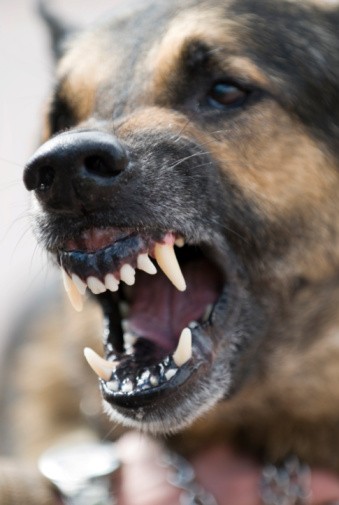
It can be frightening when a dog curls his lip, bares his teeth, growls, snarls, or bites.
Aggression is a complex behavioral issue with subtypes. For example:
- territorial/possessive aggression – "This yard (toy, food, sofa, lap) is mine! Don't come near it!" I talk more about resource guarding here and here.
- dominance-based aggression – "I'm in charge! Don't cross me!" This type of aggression directed toward people is less common than you might think. However, dominance-based aggression directed toward other dogs (especially of the same sex) is quite common.
- predatory/pursuit-based aggression – occurs when a dog has powerful instincts to chase and grab things that move (cats, chickens, small dogs, sheep, birds, bikes). The ancestry of these dogs typically includes fighting breeds, herding breeds, and/or hunting breeds. Dogs with a strong prey instinct don't necessarily have any malice toward the things they pursue or kill; they're driven by their DNA to chase, grab, shake, and kill. Of course, we can't allow them to do this, whether instinctively or not!
- reactive aggression. A reactive dog isn't truly territorial, possessive, dominant, or predatory. Instead he lives with a heightened sense of arousal where he overreacts to things in his environment that he misperceives as a threat. Reactive dogs are typically insecure, with a defensive mentality of "I'll get you before you can get me."
Now, those subtypes sound well-delineated, but when dealing with living creatures, things are seldom so clear. In fact, subtypes are somewhat fluid and dogs may be affected by any combination of them.
For example, I worked with a difficult Australian Cattle Dog named Buck, who displayed dominant aggression toward other dogs, predatory aggression toward cats, territorial aggression toward strangers, and possessive (resource-based) aggression toward his own family.
Fortunately, most aggressive dogs aren't hard cases like Buck. In fact, most of the aggression issues I see are reactive. Is your dog reactive? Let's consider what that might look like.
Living with a reactive dog
Suppose you're out for a walk and your pup spots another dog or person.
He charges to the end of the leash, lunging and growling and barking fiercely. Looks pretty aggressive, doesn't he?
But if he suddenly found himself off-leash (I'm NOT suggesting you do that!), would he run over and bite the other dog or person?
Surprisingly, most dogs would not. This is one of the signs of a reactive dog – he puts up a great front, but is too insecure to follow through. Even if he did charge the other dog or person, if his target stood its ground the reactive dog would usually retreat. In fact, if the target were to move aggressively toward the reactive dog, the latter often tucks his tail and flees.
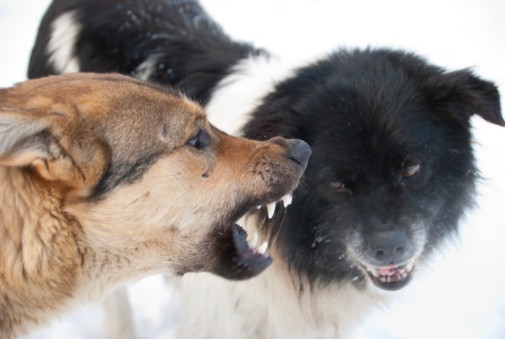
(Whereas a dog who is serious about his aggression is supremely confident. Not only does he threaten other dogs or people, but if he gets loose, he will readily attack them.)
Reactive dogs are typically anxious or frustrated, and they try to vent their anxiety or frustration with bursts of ferocity that are (mostly) bluff and bluster.
However, reactive dogs can bite if pushed too far. But even then, often they don't seem to realize they've done it until after the bite, and then they appear confused about what just happened.
Owners don't help these dogs by holding them on a tight leash, which only makes a dog feel more anxious or frustrated.
You always want your pup on a loose leash. When you need to use the leash to correct your pup, do it rapidly – pop the leash – then loosen it again. We talked about this when we covered leash training. If your pup is not responding to a normal buckle collar, switch to an alternative collar that does work.
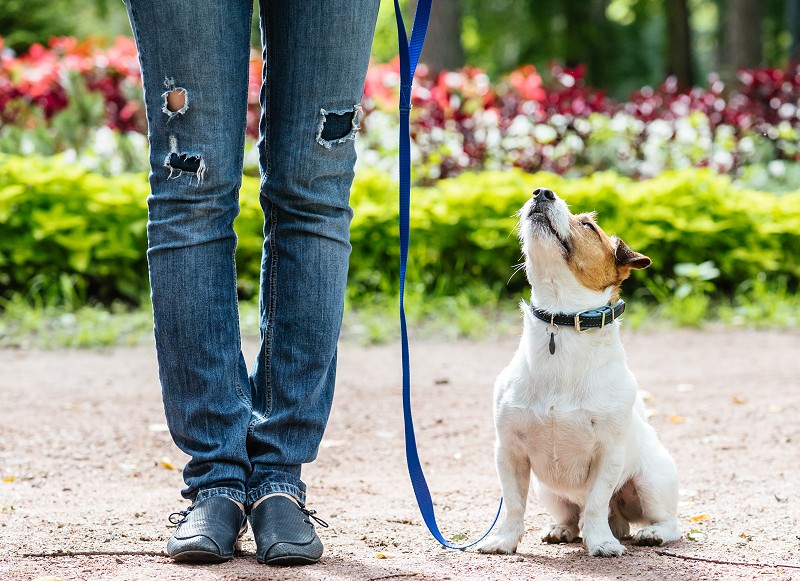
I know it's stressful to go for a walk with a pup who acts aggressively toward other people or other dogs. You tense up whenever you see someone walking toward you.
The problem is, your dog can sense your anxiety and he thinks you're worried about that approaching someone, which makes him even more likely to bellow threats.
So it's important to work on controlling your own anxiety. Slow your breathing and relax your muscles.
Most importantly, you need to put in place the proper leader-follower relationship at home. That means filling your dog's daily life with structure and routines, requiring calmness indoors, consistently rewarding good behavior and correcting bad behavior, and controlling valued resources such as food, toys, and sleeping spots. All of these topics are covered in my free online training program.
Proper leadership, all by itself, can turn many reactive dogs around by relieving the dog's insecurity. Once he trusts his leader to handle everything in his life, a pup will be more relaxed and less reactive.
What if a dog is aggressive toward his OWNER?
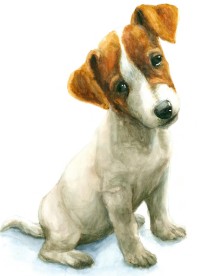 This usually doesn't appear until maturity (1 to 3 years old), when a dog's hormones blossom.
This usually doesn't appear until maturity (1 to 3 years old), when a dog's hormones blossom.
But the seeds of that aggression were actually planted in the dog's formative months. You probably weren't aware of it at the time, but it was happening.
Dogs most likely to bite their owners are those who, as youngsters, were allowed to guard their food, refuse to give up toys, demand attention, sleep on beds and furniture, jump on people, pull you around on the leash, resist grooming, rush through doors ahead of you, and other disrespectful behaviors.
As the months go by, this pup grows up with very little respect for you. You haven't earned it. So when he's bigger and older and you try to get him to do something he doesn't want to do, he resists, growls, or bites. And he fully believes that he is within his rights to do so. After all, who are you to tell him what to do? You haven't earned his respect.
Dealing with aggression or reactivity issues
Everything suggested here is covered more comprehensively in my training articles. Work through them one at a time.
- Keep the pup's leash on indoors. Dogs behaving poorly have not earned the privilege of freedom in your house. Either let the leash drag (when you're monitoring) or attach it to your waist so the dog must follow you around. Both physically and psychologically, this helps establish you as the leader and him as the follower.
- Insist upon calmness indoors – no barking, jumping, chasing, rough play, vigorous games, or racing around, indoors.
- Several times a day, practice a quick (1-minute) program of words your pup knows. Again, this is good for building a proper leader-follower dynamic.
- Once a day, go for a short structured walk.
- Once a day, require your pup to stay quietly on a comfy dog bed (this is the Place command) for an hour. Reactive dogs must learn how to relax and do absolutely nothing.
- Follow a consistent leadership-based routine for mealtimes. Have him Sit before the food goes down. Don't allow him in the room where family members are eating. And not a single morsel of food from the table.
- Limit toys. They should be a privilege, not a right.
- Keep the dog out of your bedroom. Not just off the bed – out of the bedroom entirely. He should sleep in a crate in another room. And no getting up on the furniture unless you invite him up and send him down.
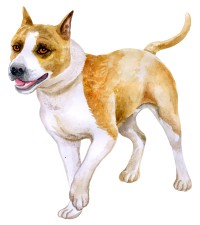 Randomly have the pup go into his crate and stay there for a short time until you let him out. Reactive dogs need to learn calmness and relaxation.
Randomly have the pup go into his crate and stay there for a short time until you let him out. Reactive dogs need to learn calmness and relaxation.- Require him to Sit before you give a treat. Make sure he takes the food gently from your hand. No grabbing.
- Don't allow him to demand petting. You decide when to pet him, and not before having him do something (Sit or Down or Place).
- Don't allow him to run through doors or gates – he must Wait until you tell him he can go through.
And if you think this is safe to do without being bitten....
- Teach the pup to accept handling all over his body.
Finally, learn the warning signs that a bite may be imminent.
People who have witnessed a biting incident often insist, "It came out of nowhere!" But virtually all dogs do give warning. You just need to know what to look for.
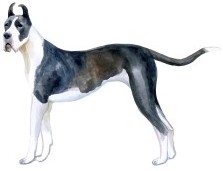 Often these warning signs come over a period of time (could be minutes, hours, or days), during which time the dog becomes increasingly uncomfortable by, for example, strangers petting him, a new dog in the household, or the excited mannerisms of a child.
Often these warning signs come over a period of time (could be minutes, hours, or days), during which time the dog becomes increasingly uncomfortable by, for example, strangers petting him, a new dog in the household, or the excited mannerisms of a child.
Watch for these subtle signs that your dog is feeling stressed:
- Yawning
- Licking his lips
- The base of his ears pulled backwards
- Flicking his eyes back and forth between you and the person/thing that's worrying him
- A worried, wary, or unhappy expression on his face
- Suddenly closing his mouth and holding it closed and tense, whereas it had previously been open and relaxed
- Panting (when he's not hot or tired)
- Freezing like a statue, his body rigidly still
- Turning his head away from the thing that's stressing him, as though hoping that if he can't see it, it will go away
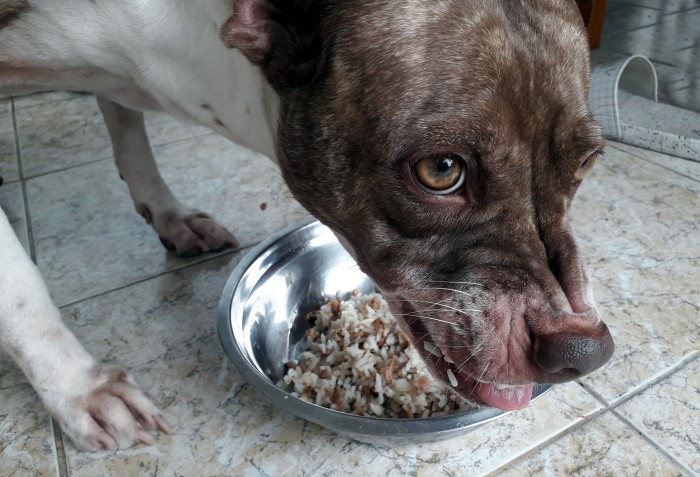
Possessive dogs who become resource guarders often look something like this.
Dogs who are possessive of their food or toys typically show different signs that a bite might be coming.
They might hover their head low over the object, their front legs splayed out on either side of it, claiming it. The rest of their body is tense and rigid. These are strong signs that a bite is coming within a few seconds unless you back off.
DO NOT work with an aggressive dog yourself if you have any concerns. Be realistic – is he only 6 months old, or 2 years old? Mini Poodle or Rottweiler? Is he just growling, or has he actually, at some point, punctured anyone's skin? If you're worried or uncertain, get professional help from a local trainer (balanced, not positive-only!)
My best-selling books – now available FREE on my website
 Respect Training For Puppies: 30 seconds to a calm, polite, well-behaved puppy is for puppies 2 to 18 months old. Your puppy will learn the 21 skills that all family dogs need to know. Click here to read for free.
Respect Training For Puppies: 30 seconds to a calm, polite, well-behaved puppy is for puppies 2 to 18 months old. Your puppy will learn the 21 skills that all family dogs need to know. Click here to read for free. Teach Your Dog 100 English Words is a unique Vocabulary and Respect Training Program that will teach your adult dog to listen to you and do what you say. Click here to read for free.
Teach Your Dog 100 English Words is a unique Vocabulary and Respect Training Program that will teach your adult dog to listen to you and do what you say. Click here to read for free. 11 Things You Must Do Right To Keep Your Dog Healthy and Happy helps your dog live a longer, healthier life. Get my honest advice about all 11 Things before you bring home your new puppy, because some mistakes with early health care cannot be undone. Click here to read for free.
11 Things You Must Do Right To Keep Your Dog Healthy and Happy helps your dog live a longer, healthier life. Get my honest advice about all 11 Things before you bring home your new puppy, because some mistakes with early health care cannot be undone. Click here to read for free.
